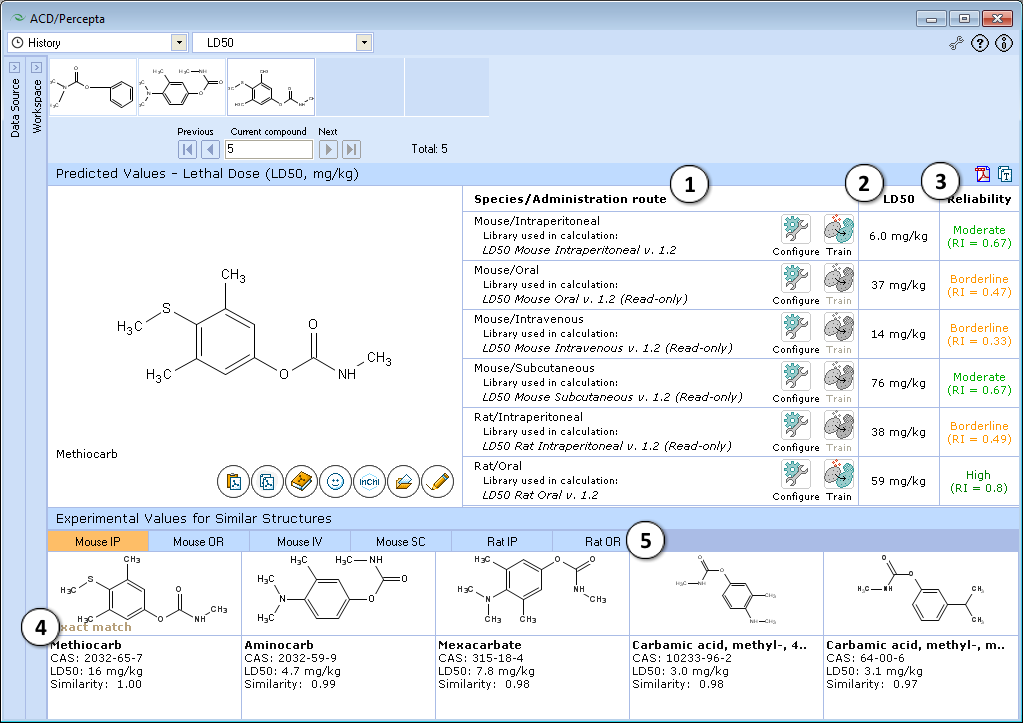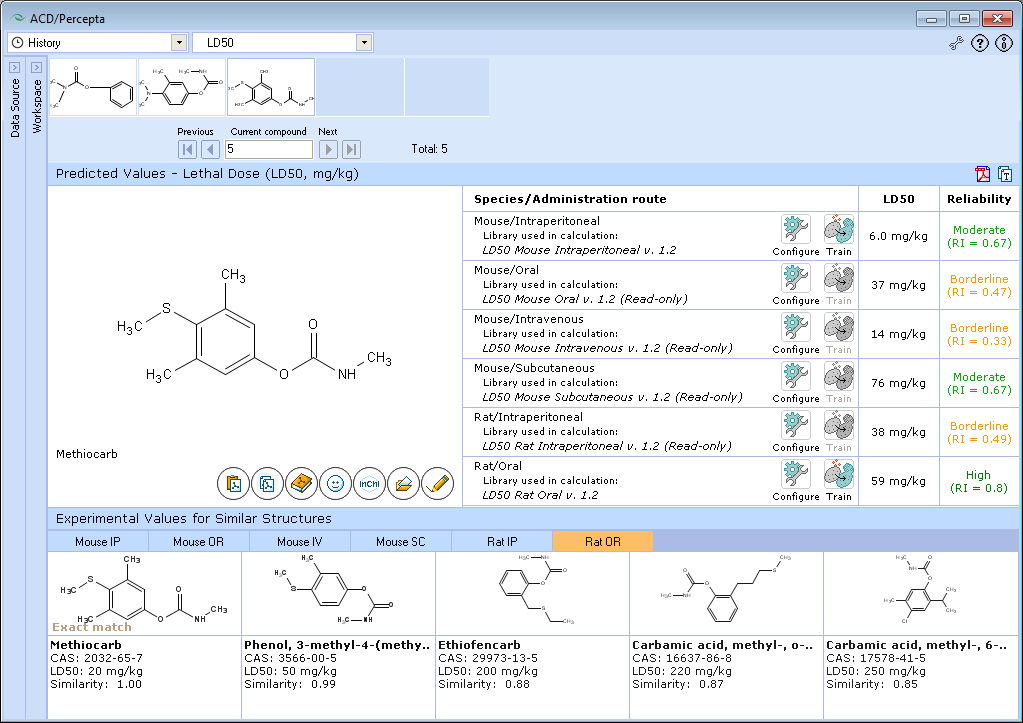Acute Toxicity LD50: Difference between revisions
| Line 19: | Line 19: | ||
[[Image:Acute_toxicity_ld50_mouse.png|center]] | [[Image:Acute_toxicity_ld50_mouse.png|center]] | ||
<br /> | <br /> | ||
# Calculations are presented in the form of a table. Each row contains dedicated "Configure" and "Train" buttons to select the training library for the particular system and to add new data to that library. The considered species/administration routes are:<br>Species: rat, mouse.<br>Administration type: intraperitoneal, oral, intravenous, subcutaneous. | # Calculations are presented in the form of a table. Each row contains dedicated "Configure" and "Train" buttons to select the training library for the particular system and to add new data to that library. The name of the library currently used in calculations is indicated with italic font.<br>The considered species/administration routes are:<br>Species: rat, mouse.<br>Administration type: intraperitoneal, oral, intravenous, subcutaneous. | ||
# Predicted LD50 in mg/kg | # Predicted LD50 in mg/kg | ||
# Reliability index (RI):<br>RI < 0.3 – Not Reliable,<br>RI in range 0.3-0.5 – Borderline Reliability,<br>RI in range 0.5-0.75 – Moderate Reliability,<br>RI >= 0.75 – High Reliability | # Reliability index (RI):<br>RI < 0.3 – Not Reliable,<br>RI in range 0.3-0.5 – Borderline Reliability,<br>RI in range 0.5-0.75 – Moderate Reliability,<br>RI >= 0.75 – High Reliability | ||
Revision as of 07:28, 25 May 2012
Overview
Acute Toxicity module performs rapid and accurate predictions of the tested compounds' LD50 values in rodents after various administration routes. The “Acute systemic toxicity” of the chemical is defined as a dose that is lethal to 50% of the treated animals. It is named lethal dose 50 (LD50). The acute toxicity (LD50) can be viewed as a “cumulative potential” to cause various acute effects and death of animals.
Features
- Calculates LD50 (mg/kg) for mouse under oral, intraperitoneal, intravenous, subcutaneous administration and for rats under oral and intraperitoneal administration methods.
- All predictions are supported by Reliability Index (RI) values that represent a quantitative evaluation of prediction confidence. High RI shows that the calculated value is likely to be accurate, while low RI indicates that no similar compounds with consistent data are present in the training set.
- Experimental LD50 value and similarity to test compound is shown for 5 most similar structures from the training set.
- The data for more than 100,000 compounds used in the development of the module were extracted from RTECS and ESIS and critically analyzed.
- Fragmental QSAR (quantitative structure-activity relationship) was used for the building of the baseline LD50 prediction model. The predictions are corrected according to the analysis of experimental LD50 values for similar compounds.
Interface

- Calculations are presented in the form of a table. Each row contains dedicated "Configure" and "Train" buttons to select the training library for the particular system and to add new data to that library. The name of the library currently used in calculations is indicated with italic font.
The considered species/administration routes are:
Species: rat, mouse.
Administration type: intraperitoneal, oral, intravenous, subcutaneous. - Predicted LD50 in mg/kg
- Reliability index (RI):
RI < 0.3 – Not Reliable,
RI in range 0.3-0.5 – Borderline Reliability,
RI in range 0.5-0.75 – Moderate Reliability,
RI >= 0.75 – High Reliability - Up to 5 most similar structures in the training set. The records include structure name, experimental value and similarity index. This index is based on QSAR analysis of logLD50 data. Similarity index varies from zero to unity. Only compounds with similarity index greater than 0.5 are presented.
- Click the tab to browse for similar structures from various administration types.

Technical information
Calculated quantitative parameter
A standard measure of acute toxicity is LD50 (lethal dose 50) defined as a dose that is lethal to 50% of the treated animals. It can be viewed as a “cumulative potential” to cause various acute effects and death of animals. To obtain a linear relationship with structural properties these data were converted to logarithmic form (pLD50) for modeling, but the final prediction results returned to the user are converted back to LD50 value (mg/kg).
In Tox Boxes LD50 is calculated for two different rodent species: toxicity for mice is estimated under oral, intraperitoneal, intravenous, subcutaneous administration, and for rats - under oral and intraperitoneal administration.
Model Features & Prediction Accuracy
Acute Toxicity predictor was built using critically evaluated experimental data for more than 100,000 compounds extracted from RTECS and ESIS databases.
Fragmental QSAR (quantitative structure-activity relationship) was used for the development of baseline LD50 prediction model. The predictions are corrected according to the analysis of experimental LD50 values for similar compounds. Predictions are supported by reliability estimation that takes into account:
- Similarity of tested compound to the training set
- Difference between predicted LD50 for tested compound and experimental values for similar compounds
- Consistence of experimental values for similar compounds.
Predictive models of LD50 in various systems have been validated on external data sets. Validation results show that the accuracy of prediction is proportional to the reliability index. The predictions with a high or moderate reliability index are accurate (average prediction error is about 0.5-0.7 log units). A high/moderate reliability index was reported for 20-50% of compounds in the validation sets.
OECD Ranges
Chemicals are assigned to one of the five Oral Acute Toxicity Hazard Categories according to the numeric criteria expressed as LD50 (oral administration to rats). Categories were defined by OECD (Organization for Economic Cooperation and Development. A Guide to The Globally Harmonized System of Classification and Labeling of Chemicals (GHS)):
- V – LD50 2000-5000 mg/kg (may be harmful if swallowed)
- IV – 300-2000 mg/kg (harmful if swallowed)
- III – 50-300 mg/kg (toxic if swallowed)
- II – 5-50 mg/kg (fatal if swallowed)
- I < 5 mg/kg (fatal if swallowed).
Toxicity hazards
Toxicity Hazards is a knowledge-based expert system that identifies and highlights structural elements that may be responsible high acute toxicity of compounds in rodents. Tox Hazards system contains a list of 86 predefined 'toxicophores' compiled after thorough analysis of toxicological literature. Significance of the defined hazardous fragments was verified on acute toxicity data set (more than 100,000 compounds).